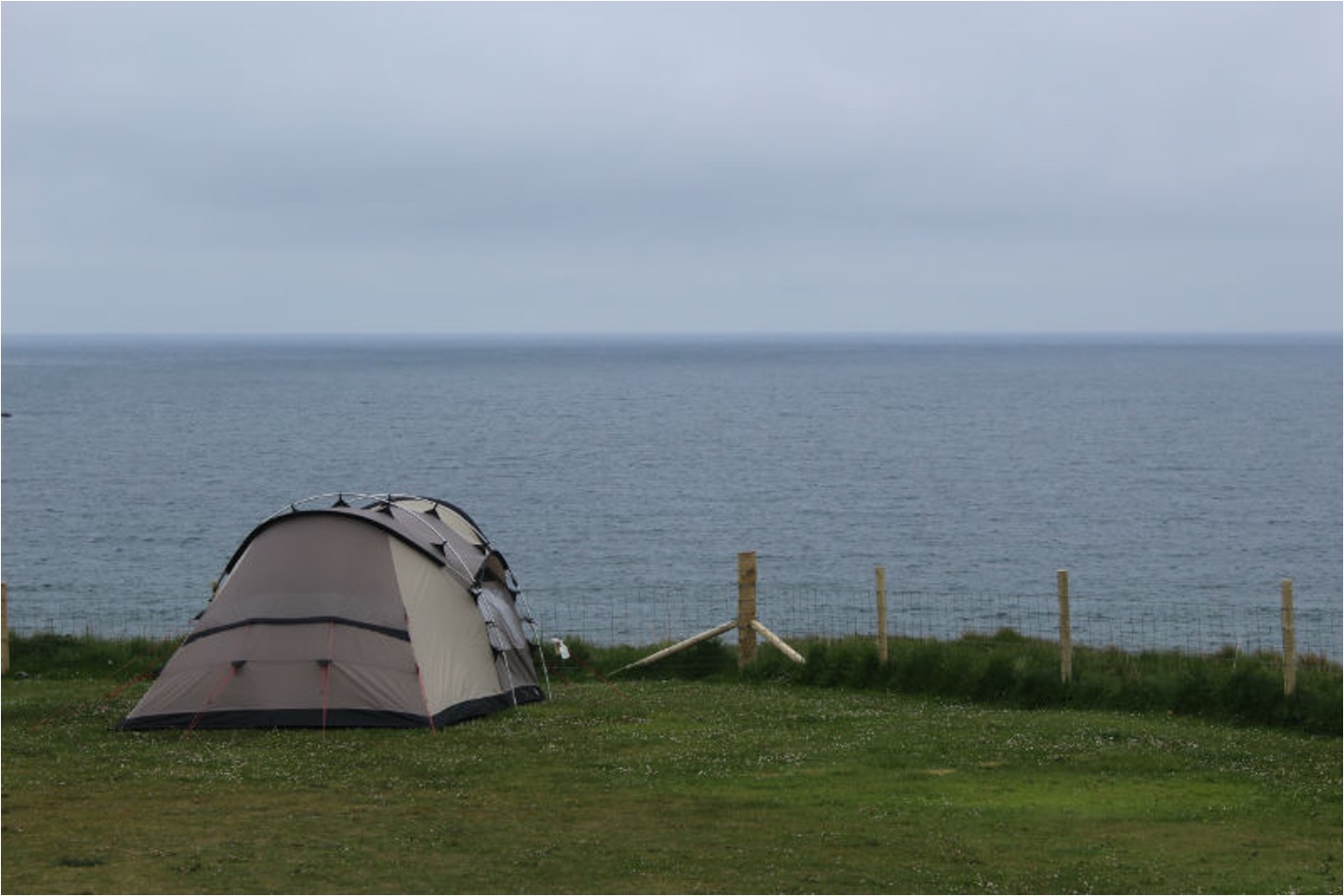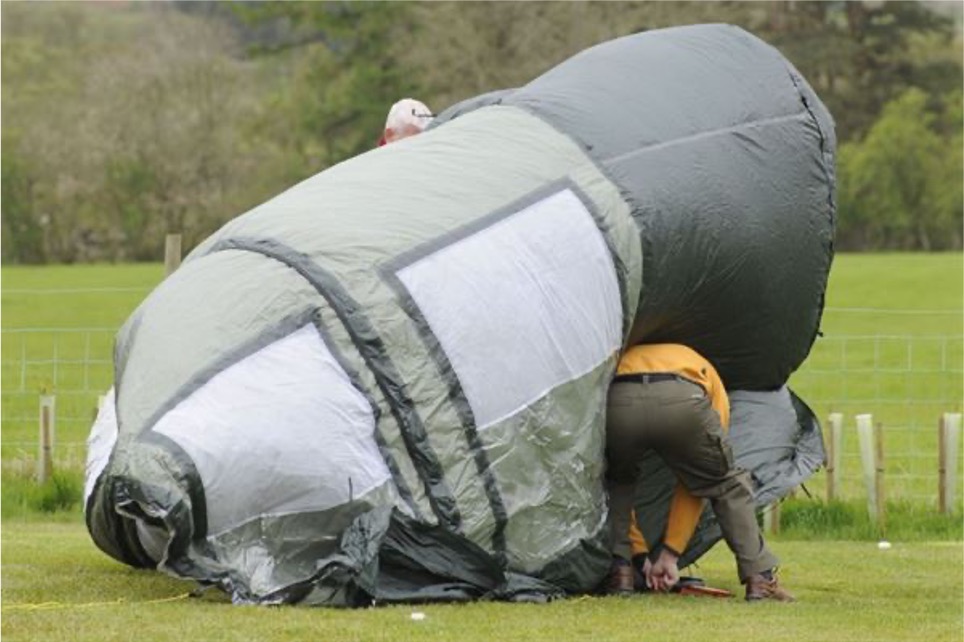Top tips for camping in windy weather
Camping in the UK often means dealing with unpredictable weather conditions, including windy and rainy days.
However, with the right knowledge and preparations, you can still enjoy a great camping experience without breaking the bank on expensive technical gear.
Here are some top tips for camping in windy weather, whether you're a seasoned camper or a novice.
Page contents
- Check the forecast
- Bring suitable gear
- Finding a suitable campsite
- Arranging your tent
- Feel the noise
- FAQs
- Final thoughts
- About our magazines
Words by Iain Duff
Check the forecast

(Photo by Iain Duff)
Before embarking on your camping trip, it's crucial to check the weather forecast for your destination. Keep an eye out for severe conditions, such as strong winds or high wind warnings.
Most tents are designed to withstand wind; however, speeds over 30mph can cause damage. Camping in such conditions can be scary but if it’s single gusts then your tent should be OK if it is pitched properly. It's essential to stay informed about the weather conditions throughout your trip.
Avoid setting up your tent during windy conditions; it's challenging and potentially dangerous. Instead, aim to arrive at your campsite before the wind picks up or wait for calmer conditions.
Bring suitable gear
Choose a quality tent
You don't need to invest in the most expensive technical tent, but avoid the cheapest options. That bargain you picked up at the supermarket won't seem quite as good when you're stranded on a windy campsite at 3am in a pile of snapped poles and mangled material.
Reputable brands subject their tents to rigorous wind and rain tests, as in the video below.
In this video, filmed at Outwell's HQ in Denmark, the windspeed was turned up to 175 km/h (110mph), the equivalent of a Category 2 storm, capable of ripping up trees, blowing the roofs off buildings and destroying mobile homes. Most people wouldn’t even consider camping in such conditions, but as you can see, the tent stood up to the battering and everyone inside during the test emerged completely dry.
In addition to the quality and design of the materials, some brands have additional features designed to improve stability, such as Outwell's Wind Stabilizer System and Vango's Tension Band System. And if things do go wrong, make sure you bring along a repair kit so you can patch your tent up as you go along.
Use the right pegs
Properly securing your tent is essential in strong winds. Make sure you use good-strength steel pegs in windy weather – you can buy grooved, wind-resistant stakes specifically for those conditions – and always drive them right into the ground.
Don't hammer the pegs into the ground straight, though, always drive them in at a 45-degree angle.
It makes them more rigid and it's actually easier to get them into the ground that way. A heavy hammer as opposed to a rubber mallet is worth having if the ground is hard or stony.
Take waterproof clothing
Remember to pack waterproof jackets and footwear for everyone in the party, in case you are forced out of the tent.
Finding a suitable campsite
Where to pitch
If you haven't pre-booked your campsite, choose a sheltered location, avoiding exposed sites on hillsides or clifftops during strong wind forecasts. Look for natural windbreaks such as hedges, hillsides, or low bushes.
Buildings, stone walls, and strategically parked cars can also offer protection. However, avoid pitching directly under trees, as branches can break and cause serious damage during strong winds.
Pitch in the right direction
When pitching your tent, consider the direction of the wind for maximum stability. Aim to direct the lowest and narrowest parts of your tent toward the wind. Pitch with the main door facing away from the wind, if you can, especially in a tunnel tent, otherwise you could find your tent taking off like a huge kite when you open the door.
Pitching properly

(Photo by Iain Duff)
Pitching your tent in windy conditions is easier with help from fellow campers. Don't be afraid to ask for assistance – you'll be surprised how many will be more than happy to help you get pitched.
Organise your gear before starting, assemble the poles, and lay them out. Begin by laying out the tent flat, quickly securing each corner as you go. Use something heavy to weigh down the groundsheet and prevent it from billowing. Keep less-stable items away from the tent edges to avoid them being buffeted by the wind. Keep a firm grip when you raise the poles into position.
Arranging your tent
Heavy items like coolboxes and storage crates can help weigh down the groundsheet and prevent it from billowing.
Keep unstable items, such as kitchen units and tables, away from the tent's edges to prevent them from being flipped over by the wind.
Don't be tempted to bring your gas stove indoors – it's not safe at the best of times and even less so when the walls of your tent are being pummelled by wind. If it's too windy to cook outdoors, use it as an excuse to go to the nearest pub for dinner!
Hanging lanterns from the roof isn't a good idea in strong winds, either, unless you enjoy being clattered on the head by a swinging chunk of plastic on a regular basis.
Feel the noise
The noise of wind whistling and flapping around your tent can be unsettling, especially at night. Try to tune it out and avoid worrying about every gust.
If you've followed the tips above and properly secured your tent, rest assured that everything should be fine. Consider using earplugs if you're particularly bothered by the noise.
FAQs
How do you stop a tent flapping in the wind?
To minimise tent flapping, ensure your tent is securely pitched with properly tensioned guylines and pegs. Use additional windbreaks or obstacles if necessary.
How do you block the wind when camping?
Seek sheltered camping spots and pitch your tent with the lowest and narrowest parts facing the wind for better protection. You can also set up a windbreak around your tent to provide shelter, or park your car in a position that gives as much protection from the wind as possible.
Final thoughts
Remember, safety should always be your top priority when camping in windy weather. It's essential to be flexible and willing to adapt to changing conditions. If the weather becomes too severe or you feel unsafe, don't hesitate to pack up and seek shelter in your car, a nearby hotel, or an on-site shelter.
Successful camping is about knowing when to stick it out and when to call it a day, ensuring a memorable and enjoyable outdoor adventure in the UK's unpredictable climate.
Expert Camping advice!

Camping magazine has been the voice of campers for over 60 years!
Camping is the UK's only magazine devoted to the wonderful world of life under canvas and the freedom it brings.
Every issue is packed with inspirational travel, the top camping sites to stay on, reviews of the latest tents, camping gear reviews, practical help and much more to help you get the most out of your camping adventures.
Want to know more about Camping magazine?
About Camping magazine








Recent Updates
Camping barbecue: our guide to cooking up a storm this summer
Is there anything more British than sausages grilled on an open flame and dropped on wet grass? Camping and barbecues go hand in hand, which is why ...
Our family camping checklist: everything you need to pack
Sure, you’ve packed the tent and the sleeping bags – but what about slip-on shoes and glow sticks? These are ...
Our guide to planning the perfect camping road trip
Roll down the window, pop on those shades and crank up the volume – it’s time for a road trip. Get ready for ...
Camping in Europe: our 12 top tips
If you’ve not camped in Europe before, there’s a few tips and tricks you’ll need to avoid some continental ...
Solar power for camping: all you need to know
Staying connected in the great outdoors is easier than ever with a solar charger – or is it? How reliable are ...
Wild camping kit list: everything you need for your next adventure
Make sure you’re ready for anything with this list of lightweight camping gear and clothing, including ...
Camping furniture: all you need to know to make your tent a cosy haven
We delve into the essentials of camping chairs, camping tables, and kitchen and bedroom furniture, ensuring ...
Camping lights for tents: What you need to know
We will guide you through all the lighting options available for you and your tent, including interior ...
Camping kitchen: all you need to know
In the great outdoors, a well-equipped camping kitchen transforms mealtime into a delightful adventure ...
How to pack away your camping gear for winter
A complete guide to packing and storing your gear at the end of the season ...
Other Articles
Camping guide to trailers
Trailer stash or trailer trash? Being able to carry lots of other gear when you go camping isn’t such a bad idea, is it? Nick Harding looks at the ...
Winter camping: all you need to know to keep warm
Winter doesn’t have to mean the end of the camping season. With good preparation and the right gear, there’s ...
Camping toilets: a complete guide
If you are wild camping, camping off-grid or the campsite you book onto doesn’t have toilet facilities, you ...
Camping tents: a complete guide
If you're considering buying a camping tent, whether it's your first time or you're a seasoned camper, making ...
Camping sleeping bags and beds: a complete guide
When it comes to camping, there's one essential item that can make or break your outdoor adventure: the ...
Camping gas: how to use gas on the campsite
A complete guide to using camping gas appliances safely on the campsite, from choosing the right stove to ...
Camping storage: a complete guide
Having problems knowing where to put all your gear when you're camping? Read our top tips and see some great ...
Camping electric hook-up: a complete guide
This is everything you need to know about using electricity on a campsite, including how to hook up ...
How to pack all your camping gear into your car
Planning a family camping holiday? Find out the best way to fit all the kit you need into your car boot, roof ...
Camping stoves and cookers: the complete guide
Camping stoves are an essential part of any outdoor adventure, allowing you to prepare meals and hot drinks ...